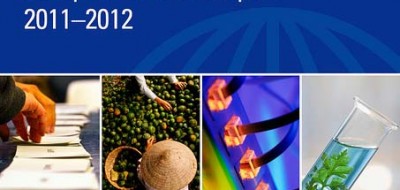Switzerland is (again) the most competitive country in the world
In the new release of the Global Competitiveness Report 2011-2012 countries that constitute the top 10 of the Global Competitiveness Index (GCI) remain the same as last year, with some changes in rank among them.
Switzerland remains first: Switzerland retains its 1st place position, characterized by an excellent capacity for innovation and a very sophisticated business culture, ranked 4th for its business sophistication and 2nd for its innovation capacity. Switzerland’s scientific research institutions are among the world’s best, and the strong collaboration between the academic and business sectors, combined with high company spending on R&D, ensures that much of this research is translated into marketable products and processes, reinforced by strong intellectual property protection and government support of innovation through its procurement processes.
Singapore best institutions: moves up by one place to 2nd position, maintaining the lead among Asian economies. The country’s institutions continue to be assessed as the best in the world, ranked 1st for both their lack of corruption and government efficiency. Singapore places 1st and 2nd, respectively, for the efficiency of its goods and labor markets and leads the world in terms of financial market development, ensuring the proper allocation of these factors to their best use.
United States in decline: continues the decline that began three years ago, falling one more position to 5th place. While many structural features continue to make its economy extremely productive, a number of escalating weaknesses have lowered the US ranking in recent years. US companies are highly sophisticated and innovative, supported by an excellent university system that collaborates admirably with the business sector in R&D. On the other hand the business community continues to be critical toward public and private institutions (39th). A lack of macroeconomic stability continues to be the United States’ greatest area of weakness (90th).
Improving China: Up one positions to 26th place, China has reinforced its position within the top 30. The world’s most populous countrycontinues to lead the BRICS economies by a significant margin. Good macroeconomic situation, low debt, high savings and high standards in health and education are some of the strengths of the country.
Qatar is here to stay: Qatar, ranked 14th, remains in the top 20 for second consecutive year and reaffirms its position as the most competitive country in the region. Its good score is mainly due to sustained by improvements in its macroeconomic environment, business sophistication, and innovation. Its strong performance in terms of competitiveness rests on solid foundations made up of a high-quality institutional framework where it ranks 14th overall, a stable macroeconomic environment (5th), and an efficient goods market (17th).
Brazil, better but not best: improves five places to rank 53rd overall. The country benefits from several competitive strengths, including one of the world’s largest internal markets (10th) and a sophisticated business environment (31st), thus allowing for important economies of scale and scope. But Brazil still suffers from weaknesses that hinder its capacity to fulfill its tremendous competitive potential. The lagging quality of its overall infrastructure (104th) despite its Growth Acceleration Programme (PAC), its macroeconomic imbalances (115th), the poor overall quality of its educational system (115th), the rigidities in its labor market (121st), and insufficient progress to boost competition (132nd) are areas of increasing concern.
Really bad Greece: Greece falls another seven places in the rankings to 90th, remaining the lowest-ranked country of the European Union. In the context of the ongoing sovereign debt crisis, Greece continues to fall precipitously in the macroeconomic environment pillar, dropping to 140th position this year. Similarly, Greece’s financial markets are assessed more poorly than in the past, at 110th this year, showing particularly low confidence on the part of investors. The evaluation of public institutions (e.g., government efficiency, corruption, undue influence) continues to suffer and is ranked a low 89th overall. Another major area of concern is the country’s inefficient labor market (126th).
What does competitiveness stand for?
According to the authors competitiveness is the “set of institutions, policies, and factors that determine the level of productivity of a country. The level of productivity, in turn, sets the sustainable level of prosperity that can be earned by an economy. In other words, more competitive economies tend to be able to produce higher levels of income for their citizens. The productivity level also determines the rates of return obtained by investments (physical, human, and technological) in an economy.”
Economic recovery, unequally distributed
The 12 pillars of competitiveness
The best way for Rwanda to improve its competitiveness is not the same as the best way for Germany to do so. This is because Rwanda and Germany are in different stages of development: as countries move along the development path, wages tend to increase and, in order to sustain this higher income, labor productivity must improve.
The GCI assumes that, in the first stage, the economy is factor-driven and countries compete based on their factor endowments: primarily unskilled labor and natural resources. Here is when the first 4 pillars (grouped under the category Basic requirements) play a role within what is been called factor-driven economies.
Factor-driven economies: basic requirements• Institutions• Health and primary education• Macroeconomic environment• Infrastructure
According to the authors’ approach, as a country becomes more competitive, productivity will increase and wages will rise with advancing development. Countries will then move into the efficiency-driven stage of development, when they must begin to develop more efficient production processes and increase product quality because wages have risen and they cannot increase prices. At this point, competitiveness is increasingly driven by what’s been called efficiency enhancers.
Efficiency-driven economies: efficiency enhancers• Higher education and training• Goods market efficiency• Labor market efficiency• Financial market development• Technological readiness• Market size
Innovation-driven economies: innovation and sophistication factors• Business sophistication• Innovation
Where does the data come from?
The 2011-2012 editionThis year’s Report features a record number of 142 economies, and thus continues to be the most comprehensive assessment of its kind. It contains a detailed profile for each of the economies featured in the study as well as an extensive section of data tables with global rankings covering over 100 indicators.









